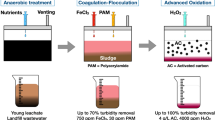Abstract
An anoxic fixed film bioreactor (FFB) with biomass immobilized on activated carbon and an aerobic continuous stirred tank bioreactor with overflow were applied to degrade concentrate from nanofiltration of real textile effluents containing Reactive Red 120 (RR-120). The efficiency of color removal was 99 % irrespective of the fraction of nanofiltration concentrate in the feed. An approximate dye balance based on the assessed adsorption capacity of RR-120 by activated carbon indicated that the dye was removed by means of adsorption as well as of biological processes. Aromatic amine released from a dye molecule was fully adsorbed by activated carbon. COD level in the outflow of the system was above that imposed by legislation. Despite an adjustment of the feed pH to 7 this was constantly increasing up to the value above 9 in both reactors. Neither the nanofiltration concentrate nor the effluents from the bioreactors affected the growth of Pseudomonas putida used as toxicity indicator.
Similar content being viewed by others
References
Allègre, C., Moulin, P., Maisseu, M., & Charbit, F. (2006). Treatment and reuse of reactive dyeing effluents. Journal of Membrane Science, 269, 15–34. DOI: 10.1016/j.memsci.2005. 06.014.
Barragán, B. E., Costa, C., & Márquez, M. C. (2007). Biodegradation of azo dyes by bacteria inoculated on solid media. Dyes and Pigments, 75, 73–81. DOI: 10.1016/j.dyepig.2006. 05.014.
Council Directive (1991). Council Directive 91/271/EEC of 21 May 1991 concerning urban wastewater treatment. Brussels: The Council of the European Communities.
Faria, P. C. C., Órfão, J. J. M., Figueiredo, J. L., & Pereira, M. F. R. (2008). Adsorption of aromatic compounds from the biodegradation of azo dyes on activated carbon. Applied Surface Science, 254, 3497–3503. DOI: 10.1016/j.apsusc.2007.11.043.
Frijters, C. T. M. J., Vos, R. H., Scheffer, G., & Mulder, R. (2006). Decolorizing and detoxifying textile wastewater, containing both soluble and insoluble dyes, in a full scale combined anaerobic/aerobic system. Water Research, 40, 1249–1257. DOI: 10.1016/j.waters.2006.01.013.
Hassan, S. S. M., Awwad, N. S., & Aboterika, A. H. A. (2009). Removal of synthetic reactive dyes from textile wastewater by Sorel’s cement. Journal of Hazardous Materials, 162, 994–999. DOI: 10.1016/j.jhazmat.2008.05.138.
Hessel, C., Allegre, C., Maisseu, M., Charbit, F., & Moulin, P. (2007). Guidelines and legislation for dye house effluents. Journal of Environmental Management, 83, 171–180. DOI: 10.1016/j.jenvman.2006.02.012.
Işik, M., & Sponza, D. T. (2007). Fate and toxicity of azo dye metabolites under batch long-term anaerobic incubations. Enzyme and Microbial Technology, 40, 934–939. DOI: 10.1016/j.enzmictec.2006.07.032.
Kapdan, I. K., & Alparslan, S. (2005). Application of anaerobic-aerobic sequential treatment system to real textile wastewater for color and COD removal. Enzyme and Microbial Technology, 36, 273–279. DOI: 10.1016/j.enzmictec.2004.08.040.
Klepacz-Smółka, A., Paździor, K., Ledakowicz, S., Sójka-Ledakowicz, J., Mrozińska, Z., & Żyłła, R. (2009). Kinetic studies of the decolourisation of concentrates from nanofiltration treatment of real textile effluents in anaerobic/aerobic sequencing batch reactors. Environment Protection Engineering, 3, 145–155.
Lucas, M. S., & Peres, J. A. (2007). Degradation of Reactive Black 5 by Fenton/UV-C and ferrioxalate/H2O2/solar light processes. Dyes and Pigments, 74, 622–629. DOI: 10.1016/j.dyepig.2006.04.005.
Ong, S.-A., Toorisaka, E., Hirata, M., & Hano, T. (2008). Granular activated carbon-biofilm configured sequencing batch reactor treatment of C.I. Acid Orange 7. Dyes and Pigments, 76, 142–146. DOI: 10.1016/j.dyepig.2006.08.024.
Pandey, A., Singh, P., & Iyengar, L. (2007). Bacterial decolorization and degradation of azo dyes. International Biodeterioration & Biodegradation, 59, 73–84. DOI: 10.1016/j.ibiod. 2006.08.006.
Paździor, K., Klepacz-Smółka, A., Ledakowicz, S., Sójka-Ledakowicz, J., Mrozińska, Z., & Żyłła, R. (2009). Integration of nanofiltration and biological degradation of textile wastewater containing azo dye. Chemosphere, 75, 250–255. DOI: 10.1016/j.chemosphere.2008.12.016.
Pengthamkeerati, P., Satapanajaru, T., & Singchan, O. (2008). Sorption of reactive dye from aqueous solution on biomass fly ash. Journal of Hazardous Materials, 153, 1149–1156. DOI: 10.1016/j.jhazmat.2007.09.074.
Qin, J.-J., Oo, M. H., & Kekre, K. A. (2007). Nanofiltration for recovering wastewater from a specific dyeing facility. Separation and Purification Technology, 56, 199–203. DOI: 10.1016/j.seppur.2007.02.002.
van der Zee, F. P., Bisschops, I. A. E., Lettinga, G., & Field, J. A. (2003). Activated carbon as an electron acceptor and redox mediator during the anaerobic biotransformation of azo dyes. Environmental Science & Technology, 37, 402–408. DOI: 10.1021/es025885o.
van der Zee, F. P., Bouwman, R. H. M., Strik, D. P. B. T. B., Lettinga, G., & Field, J. A. (2001). Application of redox mediators to accelerate the transformation of reactive azo dyes in anaerobic bioreactors. Biotechnology and Bioengineering, 75, 691–701. DOI: 10.1002/bit.10073.
Wang, X., Zhu, N., & Yin, B. (2008). Preparation of sludge-based activated carbon and its application in dye wastewater treatment. Journal of Hazardous Materials, 153, 22–27. DOI: 10.1016/j.jhazmat.2007.08.011.
Wu, J., Doan, H., & Upreti, S. (2008). Decolorization of aqueous textile reactive dye by ozone. Chemical Engineering Journal, 142, 156–160. DOI: 10.1016/j.cej.2007.11.019.
Żyłła, R., Sójka-Ledakowicz, J., Stelmach, E., & Ledakowicz, S. (2006). Coupling of membrane filtration with biological methods for textile wastewater treatment. Desalination, 198, 316–325. DOI: 10.1016/j.desal.2006.02.008.
Author information
Authors and Affiliations
Corresponding author
Rights and permissions
About this article
Cite this article
Klepacz-Smółka, A., Sójka-Ledakowicz, J., Paździor, K. et al. Application of anoxic fixed film and aerobic CSTR bioreactor in treatment of nanofiltration concentrate of real textile wastewater. Chem. Pap. 64, 230–236 (2010). https://doi.org/10.2478/s11696-009-0115-6
Received:
Revised:
Accepted:
Published:
Issue Date:
DOI: https://doi.org/10.2478/s11696-009-0115-6




